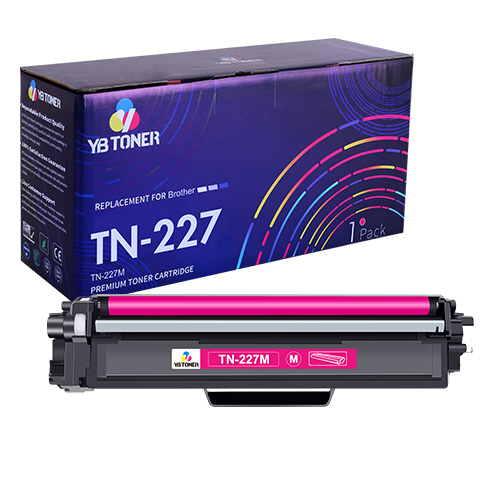What Colors of Ink Do Color Printers Use?
In the world of printing, color plays a vital role in adding an element of vibrancy and life to your documents, graphics and photos. Color printers are essential devices in homes and offices, seamlessly producing a spectrum of hues in print outputs.
You may be wondering about the ink colors your printer uses to create shadows and tones. Brother toners come in different colors including black, yellow, magenta, and cyan. From time to time you may receive warnings that a specific color is low, which means different printouts use different colors.
Colors combine to create the variety of colors you print every day. Newer printer models may have additional colors including gray, light, and light magenta. Different amounts and proportions of available ink are placed as dots on the paper to produce different colors in the printout.
A complex computer chip inside the printer converts image data into instructions sent to the printhead, which communicates with the ink cartridges about how and when to produce tiny droplets of ink. The rest of this article broadly explains the ink colors used by color printers.
Ink Cartridge Colors

Ink cartridges are not just containers of colorful liquids but sophisticated components designed to work with printers and contribute to accurate reproduction of hard copies of different document types.
The cartridges are meticulously engineered to house specific types of inks formulated for color printing. They fit into designated slots within your color printers to ensure precise and controlled ink delivery onto paper sheets. The composition of the ink colors inside the cartridges is an important element of the functionality of your printer.
When you understand the functions of the ink color cartridges, you grasp their importance in the printing process. Every cartridge contributes to creating a wide range of colors through a combination of color mixing and ink deposition.
The ink color cartridges contribute to the color mixing process. Your printer deposits tiny dots of magenta, cyan, yellow, and black in different intensities to create the illusion of different colors when viewed from a distance.
Color mixing enables your printer to reproduce diverse and rich hues in digital images. Ink color cartridges are designed to give your documents precision. The controlled release of ink ensures that every dot is accurately placed on paper to contribute to the sharpness and clarity of your print outputs, including text, photographs, and graphics.
The Colors that Color Printers Use
Color printer ink cartridges rely on yellow, cyan, magenta, and black colors. When reproducing a print output, the color values can be combined to create different colors.
Your printer creates small dots with four colors placed at different angles to accurately reproduce images, graphics, and texts. These aspects of color printing are used in the different printers in your business or home office. Color printers use the following colors.
1. Yellow

Instead of being used extensively throughout your documents, yellow ink is used for specific elements in your print output, such as sunlit areas, highlights, and distinct color combinations.
As a result, yellow ink is used less frequently and is often overshadowed by more prevalent colors that give your output a broad range of colors.
2. Cyan
Cyan or blue is a hue which lies between green and blue. It is a colorimetrically defined color that renders shades commonly used in graphics, illustrations, and images.
The intensity of the cyan color and the need for smooth transitions in your print output can result in higher ink usage.
3. Black

The color black on the printer is denoted as K, which stands for key. It is a key color used in printing to define major details, such as lines, texts, and high-contrast elements.
When you use a separate black color instead of combining colors to get black, you can get better reproduction of text and lines in your print outputs. Some printers combine colors to get black instead of using the black cartridge.
This is because pure black can smudge, while combining yellow, cyan, and magenta can give your document a sharper and richer black theme.
Also, black in your ink color cartridge helps keep the printhead nozzles clean. This minimizes the possibility of undertaking maintenance or repair. Your printer may use color ink mixed with black to ensure accurate color reproduction during calibration.
The key plate of black printing ensures that your print outputs have the necessary color depth, contrast, and intensity.
The other colored plates in your printer are aligned on the key plate. Moreover, the black fraction in the print determines the depth of colors in your print outputs.
Black ink color is important for the achromatic composition of images, which prevents too many colors from being printed on top of each other.
4. Magenta

Magenta is colloquially referred to as red, but it is actually red-blue or bright purple. It denotes an additive mixture of the maximum intensities of blue and red and varies significantly from the magenta of the red, green, and blue on screens.
The color absorbs green light and is important in generating a range of red and purple colors in your print output. When magenta combines with cyan, it produces a palette of colors when you print a colored document.
Your printer can produce countless colors. For example, if you print an image, every ink has a value ranging from 0 to 100. Zero means that none of the ink is used, while 100 implies that the image is saturated with the specific ink color.
If you want to print an image of green grass, you may combine 75 cyan, 70 yellow, 31 black, and 0 magenta. Alternatively, if you want to print a picture of a truck, you may use 92 magenta, 98 yellow, 33 black, and 0 cyan.
Some types of printers, such as inkjet printers, achieve their outputs through subtractive color mixing. It is a process that involves ink absorption of some colors and given amount of light. The light then reflects to your eyes, creating what you see as different colors.
No ink dots are needed when you want your output color to be white. This is because the white paper sheets printed upon will show through. If you want your print output to contain black, your printer uses large dots of all the inks.
Alternatively, a red output requires your printer to use yellow and magenta ink. Magenta absorbs the green light, while yellow absorbs the blue light, resulting in a reflection of red light back to your eyes.
Your printer makes color outputs in the same way paint colors are used on a palette. For example, you get green if you mix yellow and blue paints on your palette. Your printer uses the same approach to make colors through tiny droplets of controlled mixtures of ink in color cartridges.
What Do Different Colors in Your Ink Cartridge Mean?
Color is a major element of printing, and there are different colors in your ink cartridge. The different colors in your ink cartridge have different functions and meanings.
The color printers’ cyan, magenta, yellow, and black colors combine with the subtractive CMYK model in color printing and description of the entire printing process.
The model masks colors on a lighter and white background, and the ink reduces the light that would otherwise be reflected. Below are the meanings of the different colors in your ink cartridge.
- Cyan: This is a hue between blue and green and a colorimetrically defined color in daylight D50.
- Magenta: The name of the color of the ink cartridge is derived from the Italian city of Magenta, where so much blood was spilled in 1859 until the ground turned red. It is colloquially referred to as red and denotes an additive mixture of blue and red.
- Yellow: This is for the color yellow, and it is probably the best color in the CMYK model. However, there are restrictions when playing the pure forms of yellow tones.
- Black: K in the CMYK model is an abbreviation for the color black because it is a key plate, and all the other color plates are aligned to it. It is at the core of the printing process because it defines lines and texts and also determines the depth of the colors in your print output.
Conclusion
Allowing your printer to use full color even if your document is black and white gives you the best quality outputs. Also, the use of full color makes it possible for you to get bold outputs of your print texts and the most precise and sharpest images your printer can give.
If you choose to reduce the use of colors in your project, your print output may be of lower quality. Your printer uses less color ink when you print in black and white, making your printouts look faded and less crisp. However, there are times when you can only use black, especially if you are printing drafts that you will use for proofreading purposes only.
If you are confused about which color ink cartridge to choose, you can directly browse the related products on the YB toner website to get the information you need.
Click to learn: The ultimate brother toner guide

